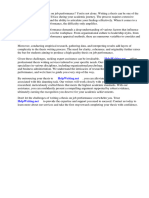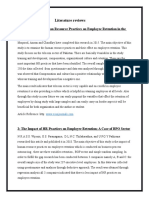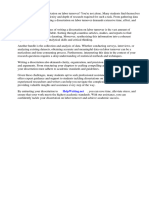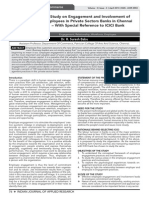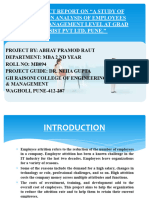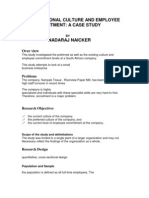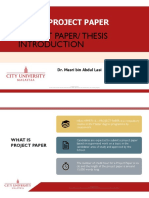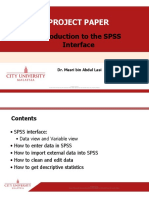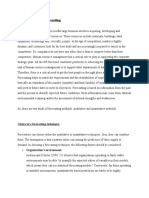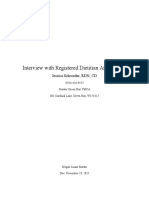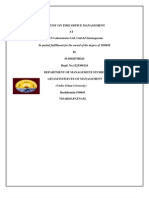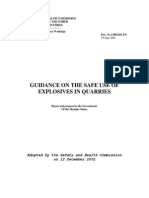JPNR - S08 - 62
JPNR - S08 - 62
Uploaded by
Raguwaran SamayyahCopyright:
Available Formats
JPNR - S08 - 62
JPNR - S08 - 62
Uploaded by
Raguwaran SamayyahOriginal Title
Copyright
Available Formats
Share this document
Did you find this document useful?
Is this content inappropriate?
Copyright:
Available Formats
JPNR - S08 - 62
JPNR - S08 - 62
Uploaded by
Raguwaran SamayyahCopyright:
Available Formats
A Study On Causes Of Employee Attrition
1
Dr.L.KESAVAN, 2Mrs.S.DHIVYA
1
Assistant Professor, PG and Research Department of Commerce, Kandaswami Kandar’s College , P.Velur Tk, Namakkal Dt
2
Research Scholar, PG and Research Department of Commerce, Kandaswami Kandar’s College, P.Velur Tk, Namakkal Dt
Email: dhivvia@gmail.com
DOI: 10.47750/pnr.2022.13.S08.62
Abstract
The study aimed to identify the causes of employee attrition and determine which factors influence attrition. The descriptive
research design is suitable for the study. The population of this study comprises private-sector employees. A simple random
sampling technique is adopted, and the researcher can only collect a maximum of 86 samples. The instrument will be used to
evaluate the quantitative approaches in the survey. The study found that salary affects employee attrition highly. Besides, the
ANOVA result shows no difference between the causes of employee attrition and the demographic profile of respondents. The
study concluded that organizations must take staff turnover seriously and have a strategy for reducing attrition.
Keywords: employee attrition, causes, demographic, factors and employee
Introduction
The rapidly increasing need for professional workers in the twenty-first century, which began in the second part
of the first decade, has resulted in high employee turnover, one of the numerous employee-related concerns that
plague organizations with high turnover. Employers are concerned about the impact of a high turnover rate on
organizational efficiency and the necessity for ongoing recruitment and accompanying expenses. They are also
concerned about the ongoing cost of recruitment. Typically, an employee stays with the same employer throughout
their career. People frequently work for the same company their entire careers.
Similarly, the employer must provide him with work until he achieves his professional and personal objectives. It
entails both parties developing and changing the framework of their relationship and engaging in mutual,
reciprocal exchanges. This relationship is uncertain for both the employee and the employer. Both parties may
have contributed to the partnership’s demise. Employee attrition is an increasing concern for all types of
businesses. Employee attrition is costly for all firms. Companies must successfully manage their qualified and
experienced staff in today’s competitive business market. To keep employees, the sector concentrates on raising
wages. Any team leader who handles a lot of personnel faces difficulties. The majority of managers are not trained
to reduce employee turnover. Businesses perceive attrition adversely since it implies losing talented employees.
Attrition is only one problem. Employees leave with a wide range of skills and certificates. Each manager loses
12 to 18 months of income, and each employee loses 4 to 6 months.
Research problem
This study is being conducted to determine the various causes of employee attrition in the organization. It is
important to figure out why so many people leave an organization so quickly.
Objectives of the study
• To identify which factor influences the employee attrition
• To study the socio-economic profile of respondents
• To determine the causes of employee attrition in the organization
Review of literature
Shashikala and Ravindra (2013) studied the influence of employee attrition on corporate productivity. According
to the findings, businesses must develop empathy for their employees and establish more reliable and stable
relationships. The high objective of extraordinarily minimal employee attrition is unattainable. They should take
an emotional approach to the few issues that need to be handled. This is undeniably an endeavour that any
Journal of Pharmaceutical Negative Results ¦ Volume 13 ¦ Special Issue 8 ¦ 2022 479
company would recognize as bold and profitable. But the approaches set up as a result of these investigations
often give you an idea of your basic skills, which, if used correctly, can change the overall attrition chaos in a big
way.
Chaudhary (2013) emphasizes employee attrition in the education business since it can no longer be ignored.
According to the findings of this study, the reasons for frequent teaching staff turnover in colleges were the
following: the management’s uncooperative and bad attitude; politics among staff members who backbite and
vomit the same to the management; wrong and biased management policies; poor compensation policies; no voice
of employees in management decisions; the pinnacle of nepotism; a disturbed work-life balance; an unhealthy and
stagnant work environment; and the absence of HR policies.
Negi (2013) investigates the reasons for attrition from multiple perspectives. It describes how a single employee
affects both employees and companies. Consequently, many uncommon causes of attrition have been investigated
with this topic. There have also been discussions regarding the advantages of attrition. The study aimed to assess
the impact of various leadership styles on preventing employee attrition. In addition, the corrective activities have
been thoroughly investigated and addressed in this study.
Kadam and Thakar (2014) investigate the most likely causes of the rising employee attrition rate in the software
sector and potential attrition-reduction strategies. According to the survey data, individuals with an average age
of 24 and 28 years and between 2 and 4 years of experience had a higher attrition rate. According to the findings,
there has been a surge in employee attrition due to discontent with their salaries, lack of career advancement
opportunities, remuneration, and interactions with their superiors.
Jeen and Betty (2014) conducted a study to determine the influence of employee intention to leave on
organizational outcomes. Because this is qualitative research, questionnaires were used to perform the
investigation. The econometric analysis showed that turnover intention affects attrition factors like QWL, career
advancement, working hours, personal and family reasons, and relationships with internal coworkers on welfare,
working conditions, and salary.
Ampomah and Cudjor (2015) centred their research on the impact of employee turnover on businesses. A high
employee turnover rate may compromise the company’s ability to achieve its objectives. The study concluded
that the absence of promotion opportunities was the most significant factor in employee turnover at ECG.
Nevertheless, turnover has both beneficial and negative effects on the organization. These results did not
contradict one another. Although regular employee turnover provides the organization with new perspectives and
expertise, acquiring new personnel has made it more difficult. According to the study’s results, if managers want
to keep their employees longer, they should look at their working conditions and keep the workplace pleasant.
Sudha et al. (2015) aimed to answer the question, “Why do people leave their jobs?” and provide suggestions for
improving employee retention in the retail industry. The findings show an association between organizational
policy and employee retention. Also, a respondent’s current employability was directly affected by many personal
factors, such as education level, career advancement, recognition, and family.
Pillai et al. (2016) examined the factors contributing to employee turnover. In addition, structured interviews were
conducted to better comprehend the HR department’s perspective. Their research also examined employee
expectations of the organization. Their research paper is about the factors that lead to employee turnover in
organized retail and how to stop it.
Research gaps
Several studies on employee attrition and labour turnover completed in recent years were evaluated. It was
determined that numerous researchers are investigating the causes and effects of employee attrition in numerous
industries with diverse socio-demographic backgrounds. However, none of the studies has focused on the factors
contributing to employee attrition. As a result, the researcher identified this as a research gap, and to answer it, he
selected this particular topic and did this research.
Research Methodology
The descriptive research design is suitable for the study. The population of this study comprises private-sector
employees. Samples from Chennai were considered. The selection of these samples is based on probability
sampling. The study’s samples were randomly selected. The primary benefit of adopting random sampling
methods is that they are easily available at any given time and location and are cost-effective. Due to time and
budget constraints, the researcher can only collect a maximum of 86 samples. Following this, quantitative methods
are used to select which research procedures will be employed to conduct an investigation. The instrument will
be used to evaluate the quantitative approaches in the survey. The questionnaire comprises multiple-choice and
five-point Likert scale items. In addition to creating the questionnaire in Google Forms, the researcher provided
links to all approved respondents. The respondents completed the questionnaire willingly.
Data analysis
Journal of Pharmaceutical Negative Results ¦ Volume 13 ¦ Special Issue 8 ¦ 2022 480
Percentage analysis
Particulars No. of respondents Percentage
Less than 25 years 39 45.3
26 to 35 years 44 51.2
Age
36 to 45 years 2 2.3
46 to 55 years 1 1.2
Male 59 68.6
Gender
Female 27 31.4
Graduate 41 47.7
Post Graduate 42 48.8
Education qualification
Doctorate 2 2.3
Others 1 1.2
Nuclear family 67 77.9
Family type
Joint family 19 22.1
Low 20 23.3
Designation level Middle 61 70.9
High 5 5.8
Total 86 100
The table shows that the highest number of respondents belong to the age group of 26 to 35 years (51.2%). In
contrast, the second highest number of respondents belong to the age group of less than 25 years (45.3%), and the
least number of respondents belong to the age groups of 36 to 45 years and 46 to 55 years. Among 86 respondents,
59 (68.6%) were male, whereas 27 (31.4%) were female. It is found that the highest number of respondents are
males. Also, most respondents have a postgraduate degree (48.8%), followed by 47.7% of respondents having a
graduate degree, 2.3% having a doctorate, and 1.2% indicating others. However, it shows that the highest number
of respondents are from nuclear families (77.9%). In addition, it indicates that 23.3% of respondents are working
at a low level, followed by 70.9% of respondents working at a middle level and 5.8% of respondents working at
a high level. It is then concluded that most respondents are working at the middle level.
Attrition affects the organization
Particulars No. of respondents Percentage
- Cost of recruitment 52 60.5
Effects on project delivery 16 18.6
The cost of training is lost 6 7.0
The reputation of the organization 11 12.8
Leakage of knowledge to other 1 1.2
organizations
It notes that the cost of recruitment highly affects the organization. Secondly, the respondents indicate the effect
of project delivery by 18.6%. Thirdly, the reputation of the organization affects the organization by 12.8%. Lastly,
the cost of training is lost, and the knowledge leakage to other organizations affects the organization by 7% and
1.2%. Then, it can be inferred that most people who answered the question said that the cost of recruitment affects
the organization.
Factors that influence employee attrition
Particulars No. of Percentage
respondents
Factors that influence employee Salary 58 67.4
attrition Lack of work-life balance and 17 19.8
stress
Job dissatisfaction 9 10.5
Lack of career mobility 1 1.2
Organization culture 1 1.2
Total 86 100
The table above shows that 67.4% of respondents indicate that salary affects employee attrition, whereas 19.8%
of respondents indicate the lack of work-life balance and stress, 10.5% of respondents indicate job dissatisfaction,
Journal of Pharmaceutical Negative Results ¦ Volume 13 ¦ Special Issue 8 ¦ 2022 481
and 1.2% of respondents indicate the organization culture. It is then found from the above table that the highest
number of respondents indicates that salary affects employee attrition.
Avoidable causes of employee attrition
Particulars Percentage Mean SD
Dissatisfaction with pay 18.4 3.7442 1.25732
Unsuitable working hours 17.1 3.4767 1.24359
Problems with HR 15.8 3.2093 1.11794
Nature of job 16.6 3.3721 1.11721
Location of company 15.6 3.1860 1.04613
Non-co-operative attitude 16.5 3.3837 1.14961
It observes that dissatisfaction with pay is the most avoidable cause of employee attrition. The second highest
avoidable causes are unsuitable working hours, followed by job nature and non-cooperative attitude. In contrast,
the least avoidable causes are problems with HR and the company’s location. Also, the average for avoidable
causes ranges from 3.18 to 3.74. Thus, dissatisfaction with pay has the highest mean value of 3.74, whereas the
location of the company has the least mean value of 3.18. It is then concluded that dissatisfaction with pay is the
most avoidable cause of employee attrition.
Unavoidable causes of employee attrition
Particulars Percentage Mean SD
Marriage 23.1 2.7093 1.12581
Health issues or accident 25.8 3.0233 1.14765
Family problem 25.2 2.9535 1.03931
Employee’s roving nature 26.0 3.0465 .98108
It indicates that the highest number of respondents indicates the employee’s roving nature is the unavoidable cause
of employee attrition. In contrast, health issues or accidents and family problems are the second and third highest
unavoidable causes, and marriage is the least unavoidable cause. Also, the average for unavoidable causes ranges
from 2.70 to 3.04. Thus, the employee’s roving nature has the highest mean value of 3.04, whereas the marriage
has the least mean value of 2.70. It shows that the highest mean value indicates higher precision.
One way ANOVA
H0: Causes of employee attrition are not differed based on the demographic profile of respondents
H1: Causes of employee attrition differed based on the demographic profile of respondents
Particulars F Sig
Age 1.387 .253
Education .984 .405
Designation .145 .865
The ANOVA shows that the F-statistics of age secures to be 1.387, whereas education is 0.984, designation level
is 0.145, and the significance value is higher than 5%, respectively. Hence, it concludes that the stated null
hypothesis is accepted. Therefore, the result infers that the causes of employee attrition do not differ based on the
respondents’ demographic profile.
Independent sample t-test
H0: Causes of employee attrition are not differed based on the gender of respondents
H1: Causes of employee attrition differed based on the gender of respondents
Gender Mean Standard deviation F Sig
Male 2.0508 .75255
.001 .975
Female 2.4444 .64051
It is found from the above table that the female respondents secure the highest mean value of 2.44, whereas the
male respondents have the mean value of 2.05. It is evident that the calculated f-value is 0.001 and the p-value is
0.975, which means that the value is greater than 5% and is not statistically significant. Hence, the null hypothesis
is accepted and shows that the causes of employee attrition differed based on the gender of respondents.
H0: Causes of employee attrition are not differed based on the family type of respondents
H3: Causes of employee attrition differed based on the family type of respondents
Journal of Pharmaceutical Negative Results ¦ Volume 13 ¦ Special Issue 8 ¦ 2022 482
Family type Mean Standard deviation F Sig
Nuclear family 2.1642 .77062
2.085 .152
Joint family 2.2105 .63060
The above table shows that the joint family respondents secure the highest mean value of 2.21, whereas the nuclear
family has 2.16. It is evident that the calculated f-value secures as 2.085, and the significance value is 0.152,
which means that the value is higher than 5% and is not statistically significant. Hence, the null hypothesis is
accepted and concludes that causes of employee attrition do not differ based on the respondents’ family type.
Conclusions
The study aimed to identify the causes of employee attrition and determine which factors influence attrition. The
study found that most of the respondents are aged 26 to 35 years, male, and have a postgraduate degree. The
empirical findings show that the respondents work at a middle level. However, the cost of recruitment attrition
affects the organization, and salary affects employee attrition. The study reveals that dissatisfaction with pay
indicates highly avoidable causes, and employees’ roving nature indicates highly unavoidable causes. The
ANOVA result shows no difference between the causes of employee attrition and the demographic profile of
respondents. The study concluded that organizations must take staff turnover seriously and have a strategy for
reducing attrition.
References
1. Kadam, V. S., & Thakar, H. M. (2014). A study of Attrition in IT industries in Pune. International Journal of Advanced Research, 2(3),
650-656.
2. Jeen, S. B. D., & Batty, S. (2014). A study on attrition–turnover intentions in the retail industry. International Journal of Business and
Administration Research Review, 1(3), 55-61.
3. Shashikala, S., & Ravindra, S. (2013). A study on causes & control techniques for attrition rate in Indian industry. Asia Pacific Journal
of Research, 2(4).
4. Chaudhary, N. S. (2013). Attrition in the education industry. International Journal of Advanced Research in Management and Social
Sciences, 2(11), 151-115.
5. Negi, G. (2013). Employee attrition: Inevitable yet manageable. International Monthly Refereed Journal of Research In Management &
Technology, 2(1).
6. Ampomah, P., & Cudjor, S. K. (2015). The effect of employee turnover on organizations (a case study of electricity company of Ghana,
Cape Coast). Asian Journal of Social Sciences and Management Studies, 2(1), 21-24.
7. Sudha, P., Prasannakumaran, C., & Aswini, M. M. (2015). An empirical analysis of employee retention policies of selected, organized
retailers with special reference to Salem city, Tamilnadu. Asia Pacific Journal of Marketing & Management Review, 4(1), 24-35.
8. Pillai, R., Mamidi, R. T., & Kuchibhotla, H. (2016). A Study of Employee Turnover and Retention Strategies in Organized Retail in
Pune City. MERC Global’s International Journal of Social Science & Management, 3(3), 83-87.
Journal of Pharmaceutical Negative Results ¦ Volume 13 ¦ Special Issue 8 ¦ 2022 483
You might also like
- Employment Letter - Ezeh Solomon OnyekachiDocument4 pagesEmployment Letter - Ezeh Solomon OnyekachiOnyekachi Jack100% (1)
- Performance Management System at HBLDocument36 pagesPerformance Management System at HBLAli Abdullah100% (1)
- Thesis Job PerformanceDocument6 pagesThesis Job Performancefjcz1j5g100% (2)
- A Study On Employee RetentionDocument19 pagesA Study On Employee Retentionmajacreation3No ratings yet
- Literature Reviews: 1: The Impact of Human Resource Practices On Employee Retention in The Telecom SectorDocument20 pagesLiterature Reviews: 1: The Impact of Human Resource Practices On Employee Retention in The Telecom SectorFizza EjazNo ratings yet
- Dissertation On Employee Engagement PDFDocument7 pagesDissertation On Employee Engagement PDFBestPaperWritingServicesDesMoines100% (1)
- A Study On Employee Engagement in Mobis India Limited, ChennaiDocument8 pagesA Study On Employee Engagement in Mobis India Limited, ChennaiGaneshkumar SunderajooNo ratings yet
- Dissertation On Labour TurnoverDocument7 pagesDissertation On Labour TurnoverWriteMyEnglishPaperJackson100% (1)
- Effect of Performance Appraisal On StaffDocument5 pagesEffect of Performance Appraisal On StaffKimberly BrionesNo ratings yet
- PHD Thesis On Employee Engagement PDFDocument4 pagesPHD Thesis On Employee Engagement PDFgbwaj17e100% (2)
- Precarious Employment Literature ReviewDocument6 pagesPrecarious Employment Literature Reviewafdtovmhb100% (1)
- Presentation1 - Amal - Saed (1) (Autosaved)Document16 pagesPresentation1 - Amal - Saed (1) (Autosaved)Mohamed AbdoNo ratings yet
- Dissertation Employee TurnoverDocument7 pagesDissertation Employee TurnoverINeedSomeoneToWriteMyPaperSingapore100% (1)
- A Study On Engagement and Involvement of Employees in Private Sectors Banks in Chennai - With Special Reference To ICICI BankDocument3 pagesA Study On Engagement and Involvement of Employees in Private Sectors Banks in Chennai - With Special Reference To ICICI BankCma Pushparaj KulkarniNo ratings yet
- Employee Engagement With Demographic Variable Research Paper PDFDocument4 pagesEmployee Engagement With Demographic Variable Research Paper PDFrpmvtcrifNo ratings yet
- Research Paper On Employee TurnoverDocument8 pagesResearch Paper On Employee Turnoverfvesdf9j100% (1)
- 2.man Analysis of Impact of Supportive Organizational Culture On The Level of Job SatisfactionDocument6 pages2.man Analysis of Impact of Supportive Organizational Culture On The Level of Job SatisfactionImpact JournalsNo ratings yet
- Literature Review On Employees RetentionDocument8 pagesLiterature Review On Employees Retentionafdtnybjp100% (1)
- Thesis On Organizational Culture and Job SatisfactionDocument4 pagesThesis On Organizational Culture and Job Satisfactionmmwsmltgg100% (1)
- Factors Affecting Job Satisfaction Research PapersDocument4 pagesFactors Affecting Job Satisfaction Research Papersfvhqqm3b100% (1)
- Smart: Journal of Business Management StudiesDocument0 pagesSmart: Journal of Business Management StudiesvlkantetiNo ratings yet
- Employment Literature ReviewDocument5 pagesEmployment Literature Reviewc5rw1ymp100% (2)
- Literature Review On Quality of Worklife of EmployeesDocument8 pagesLiterature Review On Quality of Worklife of Employeesea59a2k5No ratings yet
- Research Paper On Employee Motivation and PerformanceDocument5 pagesResearch Paper On Employee Motivation and PerformanceefdrkqkqNo ratings yet
- I J C R B: Wasim Abbas Awan Faculty of Management Sciences, Khadim Ali Shah Bukhari Institute of TechnologyDocument8 pagesI J C R B: Wasim Abbas Awan Faculty of Management Sciences, Khadim Ali Shah Bukhari Institute of Technologynormansyah emyuuNo ratings yet
- Project On Employee Attrition AnupamaDocument6 pagesProject On Employee Attrition AnupamaIshank GuptaNo ratings yet
- Conference Paper BizardDocument25 pagesConference Paper BizardSiddharthNo ratings yet
- Factors Influencing Employee Engagement by Kimberly AlesnaDocument9 pagesFactors Influencing Employee Engagement by Kimberly AlesnaKimaii AlesnaNo ratings yet
- Course Title: Human Resource DevelopmentDocument3 pagesCourse Title: Human Resource DevelopmentAdib ShakilNo ratings yet
- Master Thesis Employee EngagementDocument4 pagesMaster Thesis Employee Engagementdanaybaronpembrokepines100% (1)
- Human Res - Ijhrmd - A Study On Employee Absenteeism in - MadhumitaDocument6 pagesHuman Res - Ijhrmd - A Study On Employee Absenteeism in - MadhumitaTJPRC PublicationsNo ratings yet
- PHD Thesis Employee EngagementDocument7 pagesPHD Thesis Employee Engagementgjhs6kja100% (2)
- A Detailed Study of The Impact of Employee Engagement On Performance and Satisfaction Level of Employees at Bajaj Allianz PVT Ltd. Alisha ZaidiDocument16 pagesA Detailed Study of The Impact of Employee Engagement On Performance and Satisfaction Level of Employees at Bajaj Allianz PVT Ltd. Alisha Zaidippkedare2727No ratings yet
- The Impact of Employee Engagement On Employee RetentionDocument5 pagesThe Impact of Employee Engagement On Employee RetentionEditor IJTSRDNo ratings yet
- 07 - Chapter 4Document21 pages07 - Chapter 4RashaNo ratings yet
- Final ProjectDocument21 pagesFinal ProjectgaurigopinathNo ratings yet
- SynopsisDocument10 pagesSynopsisKalyani SharmaNo ratings yet
- Review of LiteratureDocument9 pagesReview of LiteratureVISHNU PRIYA P 1927754No ratings yet
- Thesis Statement For Employee TurnoverDocument4 pagesThesis Statement For Employee Turnoverdeniseenriquezglendale100% (2)
- A Review of The Literature On Employee Turnover Henry OngoriDocument7 pagesA Review of The Literature On Employee Turnover Henry OngoriafmzumwfxexgaoNo ratings yet
- Research Paper On Quality of Worklife PDFDocument6 pagesResearch Paper On Quality of Worklife PDFaflbuagdw50% (2)
- Research Paper On Employee Retention in IndiaDocument8 pagesResearch Paper On Employee Retention in Indiajolowomykit2100% (1)
- Review of Literature On Absenteeism EssaysDocument7 pagesReview of Literature On Absenteeism Essaysafmzuiqllaaabj100% (1)
- Training and Development Practices and Their Influence On Workers' Job PerformanceDocument10 pagesTraining and Development Practices and Their Influence On Workers' Job PerformanceJournal of Interdisciplinary PerspectivesNo ratings yet
- Beyene Tola Sheri HRM Individual AssignmentDocument4 pagesBeyene Tola Sheri HRM Individual AssignmentBeyene Tola SheriNo ratings yet
- Thesis On Impact of Motivation On Employee PerformanceDocument7 pagesThesis On Impact of Motivation On Employee PerformanceBuyResumePaperMiamiGardens100% (2)
- Job Satisfaction Literature Review 2012Document9 pagesJob Satisfaction Literature Review 2012ea5hdhzn100% (1)
- Ijrpr5664 PDFDocument2 pagesIjrpr5664 PDFMohini MishraNo ratings yet
- Review of LiteratureDocument6 pagesReview of LiteratureSylve SterNo ratings yet
- Final DefenseDocument14 pagesFinal DefenseNicole MagnoNo ratings yet
- Relationship Between Job Satisfaction and Employee Turnover IntentionDocument16 pagesRelationship Between Job Satisfaction and Employee Turnover IntentionaNo ratings yet
- Sample Research Paper On Employee MotivationDocument7 pagesSample Research Paper On Employee Motivationpcppflvkg100% (1)
- Thesis On Employee Motivation and ProductivityDocument4 pagesThesis On Employee Motivation and ProductivityApril Smith100% (2)
- Leveraging Employee Engagement For Competitive Advantage Hrs Strategic RoleDocument6 pagesLeveraging Employee Engagement For Competitive Advantage Hrs Strategic Rolermw5gvjyskNo ratings yet
- A Project Report On "A Study of Attrition Analysis of Employees Below Management Level at Grad Assist PVT LTD, Pune."Document13 pagesA Project Report On "A Study of Attrition Analysis of Employees Below Management Level at Grad Assist PVT LTD, Pune."Shankha MaitiNo ratings yet
- Thesis Paper On Employee EngagementDocument8 pagesThesis Paper On Employee EngagementKaela Johnson100% (2)
- Organizational Culture and Employee Commitment: A Case StudyDocument12 pagesOrganizational Culture and Employee Commitment: A Case StudyAliya NaseemNo ratings yet
- Final Presentation OF "Methods of Business Research": DR - AbdullahDocument12 pagesFinal Presentation OF "Methods of Business Research": DR - Abdullahsheraz khanNo ratings yet
- Attrition Proposa22lDocument5 pagesAttrition Proposa22lAditya PandeyNo ratings yet
- Beyene Tola Sheri Human Resources Management ProjectDocument4 pagesBeyene Tola Sheri Human Resources Management ProjectBeyene Tola SheriNo ratings yet
- Employee Engagement Literature Review EssaysDocument6 pagesEmployee Engagement Literature Review Essaysc5h71zzc100% (1)
- Leadership Best Practices and Employee Performance: A Phenomenological Telecommunications Industry StudyFrom EverandLeadership Best Practices and Employee Performance: A Phenomenological Telecommunications Industry StudyNo ratings yet
- Chapter ThreeDocument10 pagesChapter ThreeRaguwaran SamayyahNo ratings yet
- An Introduction To Literature ReviewDocument13 pagesAn Introduction To Literature ReviewRaguwaran SamayyahNo ratings yet
- Employ 4Document10 pagesEmploy 4Raguwaran SamayyahNo ratings yet
- PP Lesson 1Document5 pagesPP Lesson 1Raguwaran SamayyahNo ratings yet
- Chapter Three of Your ThesisDocument10 pagesChapter Three of Your ThesisRaguwaran SamayyahNo ratings yet
- Spss Beginners 0Document12 pagesSpss Beginners 0Raguwaran SamayyahNo ratings yet
- Project Paper FormatDocument16 pagesProject Paper FormatRaguwaran SamayyahNo ratings yet
- Top 10 Rags To Riches StoriesDocument19 pagesTop 10 Rags To Riches Storiesdevikap87No ratings yet
- Human Resource ForecastingDocument7 pagesHuman Resource ForecastingAakib OmiNo ratings yet
- Letter To Governor Eric Holcomb - DWD - Complaint PDFDocument3 pagesLetter To Governor Eric Holcomb - DWD - Complaint PDFWTHRNo ratings yet
- Mba232 MHRDocument17 pagesMba232 MHRAYESHA RACHH 2127567No ratings yet
- Nacar vs. Gallery FramesDocument2 pagesNacar vs. Gallery FramesMona Liza100% (1)
- Faster Better InternetDocument5 pagesFaster Better Internetkpshf100No ratings yet
- Workday Payroll Course ContentDocument12 pagesWorkday Payroll Course ContentJason67% (3)
- Chapter 7 Communication For Work PurposesDocument11 pagesChapter 7 Communication For Work PurposesButch PicardalNo ratings yet
- Balancing Job Satisfaction Performance A Guide For Human ResourceDocument5 pagesBalancing Job Satisfaction Performance A Guide For Human ResourcevickiNo ratings yet
- Case Study Analysis - Is More Cash Worth The ClashDocument4 pagesCase Study Analysis - Is More Cash Worth The Clashsiti sri wahyuniNo ratings yet
- Checklist For H1B Extension Restamping TransferDocument1 pageChecklist For H1B Extension Restamping TransferDipti Prakash ParidaNo ratings yet
- 50 Nurses & 300 Careworkers - Japan 2Document3 pages50 Nurses & 300 Careworkers - Japan 2Joswe BaguioNo ratings yet
- Specificities Human Resource Management in It Companies: September 2023Document6 pagesSpecificities Human Resource Management in It Companies: September 2023kanayabilaaaNo ratings yet
- Interview PaperDocument7 pagesInterview Paperapi-335875079No ratings yet
- A Study On Time Office Management AT MYLAN Laboratories LTD, Unit-8, VizianagaramDocument86 pagesA Study On Time Office Management AT MYLAN Laboratories LTD, Unit-8, VizianagaramRaghuram AravalliNo ratings yet
- Esl Exam c2 01Document8 pagesEsl Exam c2 01Claudia Sedano IbañezNo ratings yet
- 1-Productivity - Concept, Measurement & ImprovementDocument30 pages1-Productivity - Concept, Measurement & ImprovementShriya Gupta0% (1)
- Guidelines For Gte - NewDocument4 pagesGuidelines For Gte - NewOfelia DavidNo ratings yet
- Competency ExamplesDocument7 pagesCompetency ExamplesAnonymous q9eCZHMuSNo ratings yet
- Blacksmith Baker Roofing Sheet Maker 1984Document157 pagesBlacksmith Baker Roofing Sheet Maker 1984Rob FurnaldNo ratings yet
- Yutui 76 T 7 RuDocument1 pageYutui 76 T 7 RuKristina KolodeevaNo ratings yet
- Communication Skills CompleteDocument33 pagesCommunication Skills CompleteBukein KennNo ratings yet
- Guidance On The Safe Use of Explosives in QuarriesDocument9 pagesGuidance On The Safe Use of Explosives in QuarriesRisantoNo ratings yet
- Eadership and AnagementDocument1 pageEadership and AnagementAmol MahajanNo ratings yet
- Council Tax Reduction - FS545997747Document9 pagesCouncil Tax Reduction - FS545997747Jahanzeb RiazNo ratings yet
- Employee HandbookDocument4 pagesEmployee Handbookgjgcfft100% (1)
- HRM Note 1 - 7 3Document92 pagesHRM Note 1 - 7 3danaietteklemariamNo ratings yet
- Bab 10 Total Quality ManagementDocument46 pagesBab 10 Total Quality ManagementChristya MahardikaNo ratings yet


